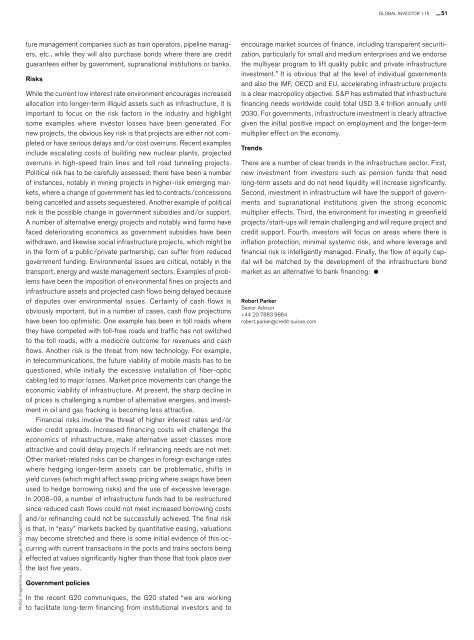Illiquid assets
Unwrapping alternative returns Global Investor, 01/2015 Credit Suisse
Unwrapping alternative returns
Global Investor, 01/2015
Credit Suisse
Create successful ePaper yourself
Turn your PDF publications into a flip-book with our unique Google optimized e-Paper software.
GLOBAL INVESTOR 1.15 — 51<br />
Photos: Imaginechina, Lowell Georgia, Anna Clopet/Corbis<br />
ture management companies such as train operators, pipeline managers,<br />
etc., while they will also purchase bonds where there are credit<br />
guarantees either by government, supranational institutions or banks.<br />
Risks<br />
While the current low interest rate environment encourages increased<br />
allocation into longer-term illiquid <strong>assets</strong> such as infrastructure, it is<br />
important to focus on the risk factors in the industry and highlight<br />
some examples where investor losses have been generated. For<br />
new projects, the obvious key risk is that projects are either not completed<br />
or have serious delays and / or cost overruns. Recent examples<br />
include escalating costs of building new nuclear plants, projected<br />
overruns in high-speed train lines and toll road tunneling projects.<br />
Political risk has to be carefully assessed; there have been a number<br />
of instances, notably in mining projects in higher-risk emerging markets,<br />
where a change of government has led to contracts / concessions<br />
being cancelled and <strong>assets</strong> sequestered. Another example of political<br />
risk is the possible change in government subsidies and / or support.<br />
A number of alternative energy projects and notably wind farms have<br />
faced deteriorating economics as government subsidies have been<br />
withdrawn, and likewise social infrastructure projects, which might be<br />
in the form of a public / private partnership, can suffer from reduced<br />
government funding. Environmental issues are critical, notably in the<br />
transport, energy and waste management sectors. Examples of problems<br />
have been the imposition of environmental fines on projects and<br />
infrastructure <strong>assets</strong> and projected cash flows being delayed because<br />
of disputes over environmental issues. Certainty of cash flows is<br />
obviously important, but in a number of cases, cash flow projections<br />
have been too optimistic. One example has been in toll roads where<br />
they have competed with toll-free roads and traffic has not switched<br />
to the toll roads, with a mediocre outcome for revenues and cash<br />
flows. Another risk is the threat from new technology. For example,<br />
in telecommunications, the future viability of mobile masts has to be<br />
questioned, while initially the excessive installation of fiber-optic<br />
cabling led to major losses. Market price movements can change the<br />
economic viability of infrastructure. At present, the sharp decline in<br />
oil prices is challenging a number of alternative energies, and investment<br />
in oil and gas fracking is becoming less attractive.<br />
Financial risks involve the threat of higher interest rates and / or<br />
wider credit spreads. Increased financing costs will challenge the<br />
economics of infrastructure, make alternative asset classes more<br />
attractive and could delay projects if refinancing needs are not met.<br />
Other market-related risks can be changes in foreign exchange rates<br />
where hedging longer-term <strong>assets</strong> can be problematic, shifts in<br />
yield curves (which might affect swap pricing where swaps have been<br />
used to hedge borrowing risks) and the use of excessive leverage.<br />
In 2008–09, a number of infrastructure funds had to be restructured<br />
since reduced cash flows could not meet increased borrowing costs<br />
and / or refinancing could not be successfully achieved. The final risk<br />
is that, in “easy” markets backed by quantitative easing, valuations<br />
may become stretched and there is some initial evidence of this occurring<br />
with current transactions in the ports and trains sectors being<br />
effected at values significantly higher than those that took place over<br />
the last five years.<br />
Government policies<br />
In the recent G20 communiques, the G20 stated “we are working<br />
to facilitate long-term financing from institutional investors and to<br />
encourage market sources of finance, including transparent securitization,<br />
particularly for small and medium enterprises and we endorse<br />
the multiyear program to lift quality public and private infrastructure<br />
investment.” It is obvious that at the level of individual governments<br />
and also the IMF, OECD and EU, accelerating infrastructure projects<br />
is a clear macropolicy objective. S & P has estimated that infra structure<br />
financing needs worldwide could total USD 3.4 trillion annually until<br />
2030. For governments, infrastructure investment is clearly attractive<br />
given the initial positive impact on employment and the longer-term<br />
multiplier effect on the economy.<br />
Trends<br />
There are a number of clear trends in the infrastructure sector. First,<br />
new investment from investors such as pension funds that need<br />
long-term <strong>assets</strong> and do not need liquidity will increase significantly.<br />
Second, investment in infrastructure will have the support of governments<br />
and supranational institutions given the strong economic<br />
multiplier effects. Third, the environment for investing in greenfield<br />
projects / start-ups will remain challenging and will require project and<br />
credit support. Fourth, investors will focus on areas where there is<br />
inflation protection, minimal systemic risk, and where leverage and<br />
financial risk is intelligently managed. Finally, the flow of equity capital<br />
will be matched by the development of the infrastructure bond<br />
market as an alternative to bank financing.<br />
Robert Parker<br />
Senior Advisor<br />
+44 20 7883 9864<br />
robert.parker@credit-suisse.com

















